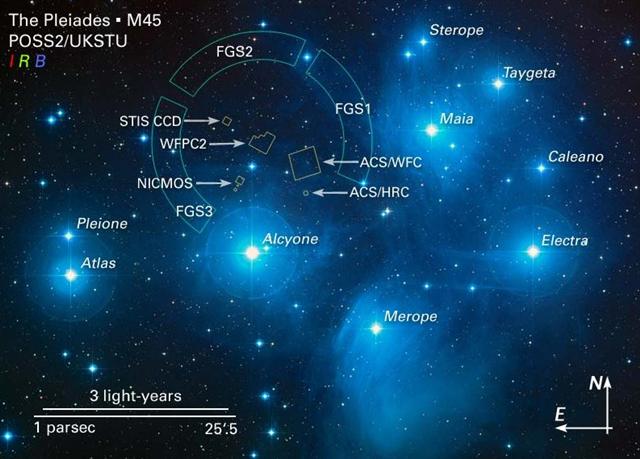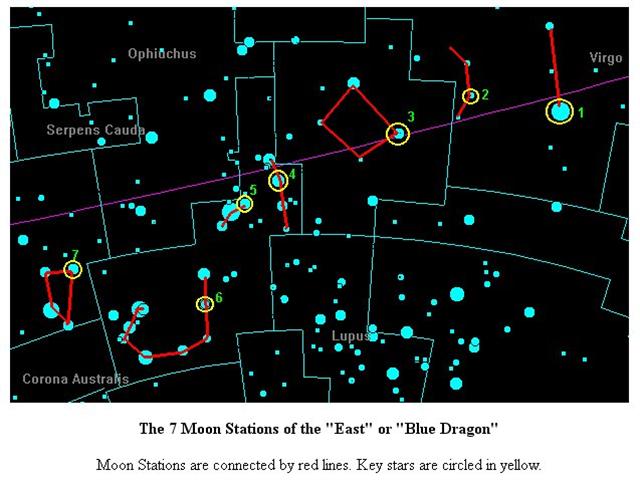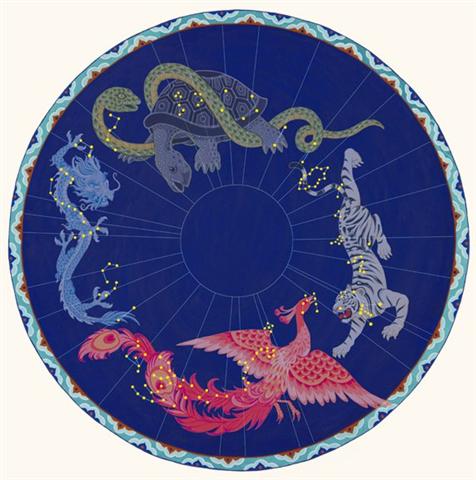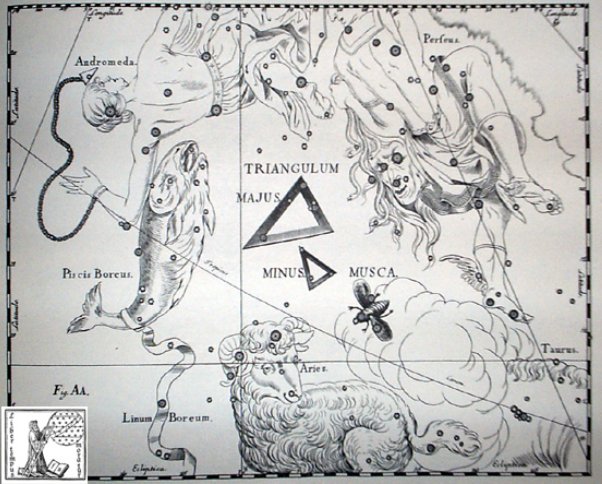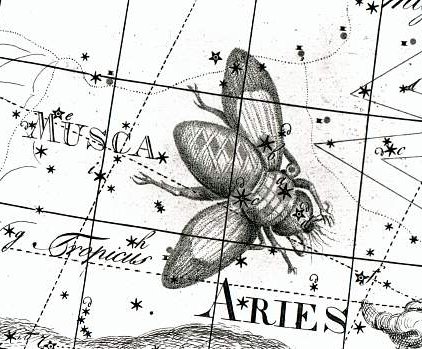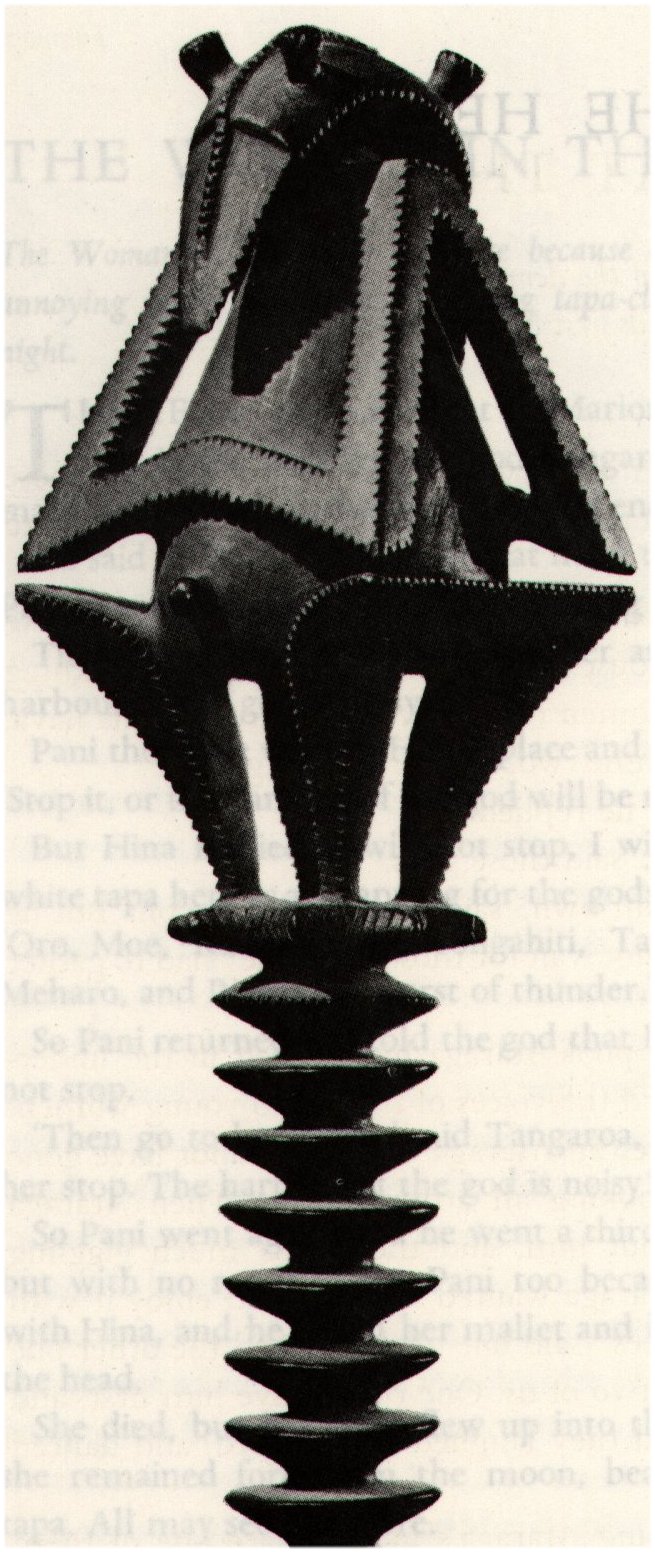381. The circuit of Lono (Rogo) was 10 days shorter than those 33 days which were counted from the return of the Pleiades late in November. Maybe this was explained as the difference between day 364 (Sun) and day 354 (Moon). *65 (Ain) - *55 (Six Stones, Tau-ono) = *10 (= 7 * 52 - 6 * 59):
The thong of the yoke stretched down from the Fox star to Spica (*202) in Virgo. Another such line of observation could possibly have gone through σ Scorpii (*247 = *202 + *45), i.e. the star marked 5 in the illustration below and just in front of Antares where the Blue Dragon ought to have had his heart: ... Antares, visible in the morning sky of December-January, came to stand for summer heat; hence the saying, 'Rehua cooks (ripens) all fruit'. The generally accepted version of the Rehua myth, according to Best, is that Rehua had two wives, the stars on either side of Antares. One was Ruhi-te-rangi or Pekehawani, the personification of summer languor (ruhi), the other Whaka-onge-kai, She-who-makes-food-scarce before the new crops can be harvested ... ... Hamiora Pio once spoke as follows to the writer: 'Friend! Let me tell of the offspring of Tangaroa-akiukiu, whose two daughters were Hine-raumati (the Summer Maid - personified form of summer) and Hine-takurua (the Winter Maid - personification of winter), both of whom where taken to wife by the sun ... Now, these women had different homes. Hine-takurua lived with her elder Tangaroa (a sea being - origin and personified form of fish). Her labours were connected with Tangaroa - that is, with fish. Hine-raumati dwelt on land, where she cultivated food products, and attended to the taking of game and forest products, all such things connected with Tane ... ... When Ira's canoe reached the islets (off the southwestern coast), Makoi (who was staying behind) shouted the following (after him): Eight lands (are there), one has been found (or, an eighth land has been found for the first time, evaru kainga katahi i revaa), that is, Te Pito O Te Kainga. During the fast journey, one cannot find the seven lands in the midst of dim twilight. Once (Easter Island) has been lost, not even eight groups of people (i.e., countless boat crews) can find (it) again. - Ruhi to the right, Pu to the left, necklace around the neck of Hinariru at Papa O Rae! (E:86)
Straight across to the White Tiger we can find an opening in Taurus where the lower jaw (earth) separated (<) from the upper jaw (sky). ... In South America the rainbow has a double meaning. On the one hand, as elsewhere, it announces the end of rain; on the other hand, it is considered to be responsible for diseases and various natural disasters. In its first capacity the rainbow effects a disjunction between the sky and the earth which previously were joined through the medium of rain. In the second capacity it replaces the normal beneficient conjunction by an abnormal, maleficient one - the one it brings about itself between sky and earth by taking the place of water ...
However, another perception could be a horizontal 'spirit level' (=) across from Libra to Musca Borealis (*41 = *64 - *23 = *59 - *18).
Counted from Bharani (*41) to the beginning of side a on the G tablet there are *64 - *41 = 23 right ascension days - as if 23 days could be counted both forward (to Betelgeuze) and backwards in time to Bharani. 5 + 18 + 18 + 5 = 36 + 10. Moon moves withershins.
The dates in Manuscript E are evidently connected with the right ascension position of Bharani and also the creator of the G text seems to have found it necessary to document the position of 41 Arietis (*41.4) - the fraction of which was used by the Arabs for fine-tuning the positions of the leading stars which rose with the Sun in spring. Counting 5 glyphs from Bharani at Gb8-8 will bring us to glyph number 454 (= 354 + 100):
And the puo (covered up, dressed) glyph is identical with that in the last glyph on side b:
... From a religious point of view, the high regard for flies, whose increase or reduction causes a similar increase or reduction in the size of the human population, is interesting, even more so because swarms of flies are often a real nuisance on Easter Island, something most visitors have commented on in vivid language. The explanation seems to be that there is a parallel relationship between flies and human souls, in this case, the souls of the unborn. There is a widespread belief throughout Polynesia that insects are the embodiment of numinous beings, such as gods or the spirits of the dead, and this concept extends into Southeast Asia, where insects are seen as the embodiment of the soul ...
The measure 23 days from 41 Arietis (*41) to Hyadum II (*64) could possibly mean the Lono effigy corresponded to Musca Borealis.
|
|||||||||||||||||||||||||||||||||||||||||||||||||||||||||||||||||||||||||||||||||||||||||||||||||||||||||||||||||||||||||||||||||||||||||||||||||||||

